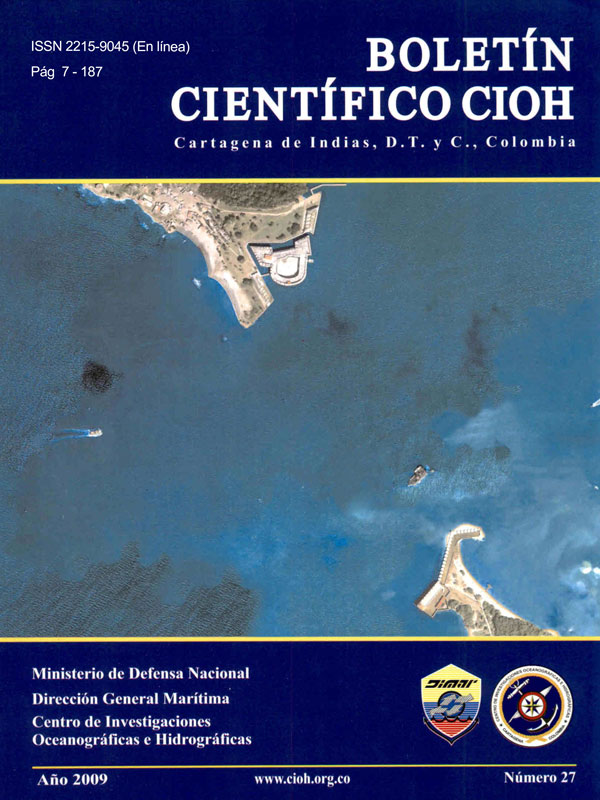Application of a wind parametric model and a spectral wave model to study maximum waves generated by hurricane Lenny, in the Colombian Caribbean coasts in 1999
DOI:
https://doi.org/10.26640/22159045.199Keywords:
Hurricanes, extreme waves, wind model, wave modelAbstract
According to the Weather Forecast Center of Mexico, on November 13, 1999, the tropical depression No. 16 of th the season was formed some 300 Km from the Grand Cayman Island; on the 14day it was classed as a tropical storm, called Lenny. For the next three days, after slow movements erratic in the beginning, the storm moved East-Southeast and then East-Northeast. In this research the maximum wave height generated with the passing of hurricane Lenny in the Colombian Caribbean coast was determined, utilizing a parametric hurricane wind model and the spectral model SWAN. The values of significant wave height in the Colombian coasts were calculated (isoline of 100 m). The Colombian Caribbean has around 1819 km of coast line where important economic and tourist cities are located such as Barranquilla, Santa Marta, Cartagena and Riohacha. The zones which were severely hit by the hurricane swell and which, hence, are more vulnerable to an event with these characteristics have been identified in this work.Downloads
References
[2] Ortiz, J. C. Huracanes y tormentas en el Caribe colombiano desde 1900. Boletín Científico CIOH 2007; 25: 54-60.
[3] Servicio Meteorológico Nacional de México [Página Web] [Actualizada 2008 diciembre 15; Citada 2009 junio 17]. Disponible en: http://smn.cna.gob.mx/.
[4] Young I. R. 1999. Wind generated ocean waves. Elsevier Science Ltd, Oxford, UK. p. 146.
[5] Visbal, J. , y Ortiz, J.C. Simulación de Huracanes bajo el lenguaje Java a partir del modelo HURWIN (Hurricane Wind Model) para su aplicación sobre la Costa Caribe colombiana. Trabajo de grado en Ingeniería de Sistemas. Universidad del Norte 2006. p. 40-52.
[6] Lizano, O. G. Modelo de vientos ajustado a un modelo de generación de olas para el pronóstico durante huracanes. Geofísica 1990; 33: 75-103.
[7] Unisys Weather Tropical Data Department [Página Web] [Actualizada 2007 febrero 1; Citada 2006 febrero 15]. Disponible en: http://weather.unisys.com/hurricane/
atlantic/index.html.
[8] Collins, J. I and J. Viehnanman. A simplified empirical model for hurricane wind fields. Paper No. OTC 1346. Offshore Technology Conference, 1971.
[9] Jelesnianski, C. P. SPLASH (Special program to list amplitudes of surges from hurricanes); part II: General tracks and variant storm conditions. NOAA, Tech. Memo. NWS TDL-52. Silver Spring, 1974.
[10] Willoughby, H. E. and Rhan M. Parametric Representation of the Primary Vortex. Part I: Observations and Evaluation of the Holland (1980) Model. Monthly Weather Review 2004:3033-3048.
[11] Booij, N. y Holthuijsen, L.H. Propagation of ocean waves in discrete spectral wave models. Journal of Computational Physics 1987; 68:307-326.
[12] Ortiz J. C. y Mercado A. An Intercomparison of SWAN and WAVEWATCH III models with data from NDBC-NOAAbuoys at oceanic scales. Coastal Engineering Journal Japan 2008 marzo; 50(1): 47-73. Boletín Científico CIOH No. 27, ISSN 0120-0542, (2009) 29-
[13] Lizano, O.G. Simulación de oleaje de huracán usando modelo de vientos paramétricos en un modelo de olas de tercera generación. Boletín Científico CIOH 2006; 24: 36-47.
[14] ETOPO 2 data base from NGDC (National Geophysical Data Center)[Página Web] [Actualizada 2009 julio 15; Citada 2008 noviembre10]. Disponible en: http://www.ngdc.noaa.gov/mgg/image/
2minrelief.html.
[15] SWAN model, user manual. [Página Web] [Actualizada 2009 marzo 11; Citada 2009 julio 22]. Disponible en: http://130.161.13.149/swan/online_doc/
swanuse/swanuse.html.
Downloads
Published
Issue
Section
License
Attribution — You must give appropriate credit, provide a link to the license, and indicate if changes were made. You may do so in any reasonable manner, but not in any way that suggests the licensor endorses you or your use.
NonCommercial — You may not use the material for commercial purposes.
NoDerivatives — If you remix, transform, or build upon the material, you may not distribute the modified material.
No additional restrictions — You may not apply legal terms or technological measures that legally restrict others from doing anything the license permits.



